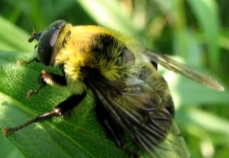Transcription of video clip Trees and other organisms
Dendrotelmata: aquatic microhabitats inside trees

© Laurent Larrieu
An example of a dendrotelma
A dendrotelma is a basin formed by a tree's wood, in which rainwater temporarily accumulates.
The environment is full of decomposing litter: dead leaves, decomposing wood and animal droppings.
Dendrotelmata are present from the ground, where a basin can be created between two roots, to all the way to the top branches.

© JC Lucier
Mallota posticata, an insect that depends on dendrotelmata
Dendrotelmata are the source of a poor but very original fauna. In Europe, about 15 insect species can populate dendrotelmata. 7 of them are dependant on those basins to complete their life-cycle.
These insects' larvae exclusively eat decomposing organic litter, algae or bacteria present in dendrotelmata.
The adults have a more diversified regime: nectar and pollen from flowers, vertebrate or insect blood or even plant sap.
There are hard-bottomed dendrotelmata: the basin's bottom is sealed by bark.
On the contrary, decayed-bottom dendrotelmata have a decomposing base.
In both cases, dendrotelma formation requires hard wood on its sides and microclimatic conditions that limit evaporation.
Many trees create dendrotelmata: maples, oaks and birches, for example. However, they are rarer in conifers.
That is a good example that the tree in itself is a habitat for living beings.
Back to video clip




